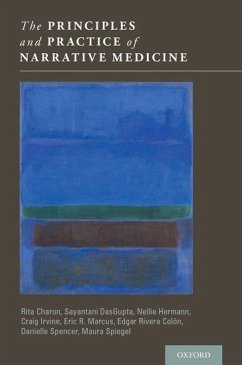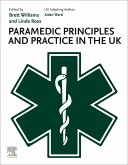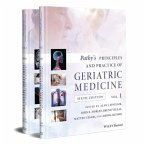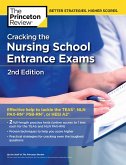Rita Charon (Columbia University ), Sayantani DasGupta (Columbia University ), Nellie Hermann (Columbia University )
The Principles and Practice of Narrative Medicine
Rita Charon (Columbia University ), Sayantani DasGupta (Columbia University ), Nellie Hermann (Columbia University )
The Principles and Practice of Narrative Medicine
- Gebundenes Buch
- Merkliste
- Auf die Merkliste
- Bewerten Bewerten
- Teilen
- Produkt teilen
- Produkterinnerung
- Produkterinnerung
The Principles and Practice of Narrative Medicine articulates the ideas, methods, and practices of narrative medicine. Written by the originators of the field, this book provides the authoritative starting place for any clinicians or scholars committed to learning of and eventually teaching or practicing narrative medicine.
Andere Kunden interessierten sich auch für
![Paramedic Principles and Practice in the UK Paramedic Principles and Practice in the UK]() Paramedic Principles and Practice in the UK90,99 €
Paramedic Principles and Practice in the UK90,99 €![A Treatise On The Principles And Practice Of Medicine V2 A Treatise On The Principles And Practice Of Medicine V2]() Austin FlintA Treatise On The Principles And Practice Of Medicine V243,99 €
Austin FlintA Treatise On The Principles And Practice Of Medicine V243,99 €![Understanding The Principles and Practice of Legal Oncology Understanding The Principles and Practice of Legal Oncology]() Tony S. QuangUnderstanding The Principles and Practice of Legal Oncology86,99 €
Tony S. QuangUnderstanding The Principles and Practice of Legal Oncology86,99 €![Pathy's Principles and Practice of Geriatric Medicine Pathy's Principles and Practice of Geriatric Medicine]() Pathy's Principles and Practice of Geriatric Medicine581,99 €
Pathy's Principles and Practice of Geriatric Medicine581,99 €![A Treatise On The Principles And Practice Of Medicine V1 A Treatise On The Principles And Practice Of Medicine V1]() Austin FlintA Treatise On The Principles And Practice Of Medicine V143,99 €
Austin FlintA Treatise On The Principles And Practice Of Medicine V143,99 €![The Practice and Principles of Surgical Assisting The Practice and Principles of Surgical Assisting]() Rebecca HallThe Practice and Principles of Surgical Assisting61,99 €
Rebecca HallThe Practice and Principles of Surgical Assisting61,99 €![Cracking the Nursing School Entrance Exams, 2nd Edition: Practice Tests + Content Review (Teas, Nln Pax-Rn, Psb-Rn, Hesi A2) Cracking the Nursing School Entrance Exams, 2nd Edition: Practice Tests + Content Review (Teas, Nln Pax-Rn, Psb-Rn, Hesi A2)]() Princeton ReviewCracking the Nursing School Entrance Exams, 2nd Edition: Practice Tests + Content Review (Teas, Nln Pax-Rn, Psb-Rn, Hesi A2)29,99 €
Princeton ReviewCracking the Nursing School Entrance Exams, 2nd Edition: Practice Tests + Content Review (Teas, Nln Pax-Rn, Psb-Rn, Hesi A2)29,99 €-
-
-
The Principles and Practice of Narrative Medicine articulates the ideas, methods, and practices of narrative medicine. Written by the originators of the field, this book provides the authoritative starting place for any clinicians or scholars committed to learning of and eventually teaching or practicing narrative medicine.
Hinweis: Dieser Artikel kann nur an eine deutsche Lieferadresse ausgeliefert werden.
Hinweis: Dieser Artikel kann nur an eine deutsche Lieferadresse ausgeliefert werden.
Produktdetails
- Produktdetails
- Verlag: Oxford University Press Inc
- Seitenzahl: 360
- Erscheinungstermin: 8. Dezember 2016
- Englisch
- Abmessung: 241mm x 164mm x 35mm
- Gewicht: 628g
- ISBN-13: 9780199360192
- ISBN-10: 0199360197
- Artikelnr.: 47812827
- Herstellerkennzeichnung
- Libri GmbH
- Europaallee 1
- 36244 Bad Hersfeld
- gpsr@libri.de
- Verlag: Oxford University Press Inc
- Seitenzahl: 360
- Erscheinungstermin: 8. Dezember 2016
- Englisch
- Abmessung: 241mm x 164mm x 35mm
- Gewicht: 628g
- ISBN-13: 9780199360192
- ISBN-10: 0199360197
- Artikelnr.: 47812827
- Herstellerkennzeichnung
- Libri GmbH
- Europaallee 1
- 36244 Bad Hersfeld
- gpsr@libri.de
Rita Charon is a general internist and literary scholar at Columbia University who originated the field of narrative medicine and directs the Program in Narrative Medicine at Columbia. She researches, publishes, and lectures extensively on the relationship between narrative knowledge and the care of the sick. Edgar Rivera Colón, Ph.D. teaches at Columbia University's program in Narrative Medicine. Dr. Rivera Colón is a sexuality and gender anthropologist. For the last fifteen years, he has been conducting ethnographic research on New York City's House Ball community. Sayantani DasGupta teaches in the MS Program in Narrative Medicine at Columbia University as well as Columbia's Center for Comparative Literature and Society. She also co-chairs Columbia's University Seminar in Narrative, Health and Social Justice and teaches at the Health Advocacy Program at Sarah Lawrence College. Nellie Hermann was born in Boston, Massachusetts, and lives in Brooklyn, New York. Her second novel, The Season of Migration, was published by FSG in January and was a New York Times Editor's Choice. She is the Creative Director of the Program in Narrative Medicine at Columbia University and has taught and lectured widely on the use of creativity in nontraditional contexts. Craig Irvine is Director of the Masters Program in Narrative Medicine at Columbia University and Director of Education of the Program in Narrative Medicine at the College of Physicians and Surgeons of Columbia University. Eric R. Marcus is Director of the Columbia University Center for Psychoanalytic Training and Research and is a training and supervising analyst there. He is a professor of clinical psychiatry at the Columbia University College of Physicians and Surgeons. Danielle Spencer is a Faculty member of the Program in Narrative Medicine at Columbia University as well as the Einstein-Cardozo Master of Science in Bioethics program in New York. Spencer presents regularly at medical humanities and bioethics conferences and has been published in The Lancet, WIRED, Creative Nonfiction, Esopus and The Hungarian Review. Maura Spiegel has been teaching fiction and film at Columbia University and Barnard College for the past 20 years. She is a founding member of the Program in Narrative Medicine at Columbia College of Physicians and Surgeons, where she offers film courses to first-year medical students.
* Acknowledgments
* Introduction
* Part I: Intersubjectivity
* Chapter 1. Accounts of Self: Exploring Relationality through
Literature
* Maura Spiegel and Danielle Spencer
* Introduction
* Self-Telling: Colm Tóibín and the Need to Tell
* Monologue and Dialogue: Dostoevsky and Bakhtin
* Recognition in Bechdel's Fun Home: Thickening the Story
* Identification and Refusal in Kazou Ishiguro's Never Let Me Go
* Conclusion
* Chapter 2. This Is What We Do, and These Things Happen: Experience,
Emotion, and Relationality In The Classroom
* Maura Spiegel and Danielle Spencer
* Socio-relational dynamics and medical education
* The Narrative Medicine Classroom / Workshop
* Conclusion
* Part II: Dualism, Personhood, and Embodiment
* Chapter 3: Dualism and its Discontents I: Philosophy, Literature, and
Medicine
* Craig Irvine and Danielle Spencer
* "Hi. How are you feeling today?": Tales of Alienation in Healthcare
* Biomedicine in recent history
* The Cave and the Machine: Philosophical Roots of Dualism
* Chapter 4: Dualism and its Discontents II: Philosophical Tinctures
* Craig Irvine and Danielle Spencer
* Philosophical Tinctures: Phenomenology and Narrative Hermeneutics
* Philosophical Narratives: Complexity and Multiplicity
* Soul
* Chapter 5: Deliver us from Certainty: Training for Narrative Ethics
* Craig Irvine and Rita Charon
* Narrative Ethics of Reading
* Narrative Ethics of Clinical Practice
* Ethics of Narrative Medicine
* Part III: Identities in Pedagogy
* Chapter 6: The Politics of Pedagogy: Cripping, Queering and Un-homing
Health Humanities
* Sayantani DasGupta
* Introduction
* Crip Politics and the Medicalization of Health Humanities
* Queer Politics and the Problems of Intelligibility
* Un-Homing Narrative Medicine: Pedagogical Frames
* Conclusion
* Part IV: Close Reading
* Chapter 7: Close Reading: The Signature Method of Narrative Medicine
* Rita Charon
* The Origin and Fate of Close Reading
* Why Narrative Medicine Is Committed to Close Reading
* Close Reading and Its Progeny, Attentive Listening
* The Interior Processes of Close Reading
* Close Reading Enacts the Principles of Narrative Medicine
* Coda
* Chapter 8: A Framework for Teaching Close Reading
* Rita Charon
* One Way to Teach Close Reading
* Choosing Texts and Creating Prompts
* Time
* Space
* Voice
* Metaphor
* Conclusions and Room for Further Thought
* Part V: Creativity
* Chapter 9: Creativity: What, Why, and Where?
* Nellie Hermann
* Creativity in Our Everyday Lives
* What is Creative Writing for, particularly in the clinical context?
* Forms and Dividends of Creative Writing
* Creative Writing and Reflective Writing
* Chapter 10: Can Creativity be Taught?
* Nellie Hermann
* Strategies for Writing in the Health Professions
* A Teaching Tool: The Reading Guide for Reflective Writing
* The Approach to the Writing Student
* Finally: focus on the creative spark
* Part VI: Qualitative Ways of Knowing
* Chapter 11: The Ethnographic Field: Narrative, Visual, Contextual
* Edgar Rivera Colón
* Narrative Prelude
* Demystifying Qualitative Research Methods
* An Embodied, Reflexive Practice
* Making the world visible
* The Ethnographic Witness
* Part VI: Clinical Practice
* Chapter 12: A Narrative Transformation of Health and Health Care
* Eric Marcus and Rita Charon
* RC Tells the Clinical Story
* EM: Concepts-Transference and Transitional Space
* RC: Concepts-Creativity, Reflexivity, Reciprocity
* Coda
* Chapter 13: Clinical Contributions of Narrative Medicine
* Rita Charon
* Individual Interview/Relationship Techniques
* Clinician and Health Care Team Development
* Novel Narrative Practices
* Clinicians See
* Author Biographies
* Bibliography
* Index
* Introduction
* Part I: Intersubjectivity
* Chapter 1. Accounts of Self: Exploring Relationality through
Literature
* Maura Spiegel and Danielle Spencer
* Introduction
* Self-Telling: Colm Tóibín and the Need to Tell
* Monologue and Dialogue: Dostoevsky and Bakhtin
* Recognition in Bechdel's Fun Home: Thickening the Story
* Identification and Refusal in Kazou Ishiguro's Never Let Me Go
* Conclusion
* Chapter 2. This Is What We Do, and These Things Happen: Experience,
Emotion, and Relationality In The Classroom
* Maura Spiegel and Danielle Spencer
* Socio-relational dynamics and medical education
* The Narrative Medicine Classroom / Workshop
* Conclusion
* Part II: Dualism, Personhood, and Embodiment
* Chapter 3: Dualism and its Discontents I: Philosophy, Literature, and
Medicine
* Craig Irvine and Danielle Spencer
* "Hi. How are you feeling today?": Tales of Alienation in Healthcare
* Biomedicine in recent history
* The Cave and the Machine: Philosophical Roots of Dualism
* Chapter 4: Dualism and its Discontents II: Philosophical Tinctures
* Craig Irvine and Danielle Spencer
* Philosophical Tinctures: Phenomenology and Narrative Hermeneutics
* Philosophical Narratives: Complexity and Multiplicity
* Soul
* Chapter 5: Deliver us from Certainty: Training for Narrative Ethics
* Craig Irvine and Rita Charon
* Narrative Ethics of Reading
* Narrative Ethics of Clinical Practice
* Ethics of Narrative Medicine
* Part III: Identities in Pedagogy
* Chapter 6: The Politics of Pedagogy: Cripping, Queering and Un-homing
Health Humanities
* Sayantani DasGupta
* Introduction
* Crip Politics and the Medicalization of Health Humanities
* Queer Politics and the Problems of Intelligibility
* Un-Homing Narrative Medicine: Pedagogical Frames
* Conclusion
* Part IV: Close Reading
* Chapter 7: Close Reading: The Signature Method of Narrative Medicine
* Rita Charon
* The Origin and Fate of Close Reading
* Why Narrative Medicine Is Committed to Close Reading
* Close Reading and Its Progeny, Attentive Listening
* The Interior Processes of Close Reading
* Close Reading Enacts the Principles of Narrative Medicine
* Coda
* Chapter 8: A Framework for Teaching Close Reading
* Rita Charon
* One Way to Teach Close Reading
* Choosing Texts and Creating Prompts
* Time
* Space
* Voice
* Metaphor
* Conclusions and Room for Further Thought
* Part V: Creativity
* Chapter 9: Creativity: What, Why, and Where?
* Nellie Hermann
* Creativity in Our Everyday Lives
* What is Creative Writing for, particularly in the clinical context?
* Forms and Dividends of Creative Writing
* Creative Writing and Reflective Writing
* Chapter 10: Can Creativity be Taught?
* Nellie Hermann
* Strategies for Writing in the Health Professions
* A Teaching Tool: The Reading Guide for Reflective Writing
* The Approach to the Writing Student
* Finally: focus on the creative spark
* Part VI: Qualitative Ways of Knowing
* Chapter 11: The Ethnographic Field: Narrative, Visual, Contextual
* Edgar Rivera Colón
* Narrative Prelude
* Demystifying Qualitative Research Methods
* An Embodied, Reflexive Practice
* Making the world visible
* The Ethnographic Witness
* Part VI: Clinical Practice
* Chapter 12: A Narrative Transformation of Health and Health Care
* Eric Marcus and Rita Charon
* RC Tells the Clinical Story
* EM: Concepts-Transference and Transitional Space
* RC: Concepts-Creativity, Reflexivity, Reciprocity
* Coda
* Chapter 13: Clinical Contributions of Narrative Medicine
* Rita Charon
* Individual Interview/Relationship Techniques
* Clinician and Health Care Team Development
* Novel Narrative Practices
* Clinicians See
* Author Biographies
* Bibliography
* Index
* Acknowledgments
* Introduction
* Part I: Intersubjectivity
* Chapter 1. Accounts of Self: Exploring Relationality through
Literature
* Maura Spiegel and Danielle Spencer
* Introduction
* Self-Telling: Colm Tóibín and the Need to Tell
* Monologue and Dialogue: Dostoevsky and Bakhtin
* Recognition in Bechdel's Fun Home: Thickening the Story
* Identification and Refusal in Kazou Ishiguro's Never Let Me Go
* Conclusion
* Chapter 2. This Is What We Do, and These Things Happen: Experience,
Emotion, and Relationality In The Classroom
* Maura Spiegel and Danielle Spencer
* Socio-relational dynamics and medical education
* The Narrative Medicine Classroom / Workshop
* Conclusion
* Part II: Dualism, Personhood, and Embodiment
* Chapter 3: Dualism and its Discontents I: Philosophy, Literature, and
Medicine
* Craig Irvine and Danielle Spencer
* "Hi. How are you feeling today?": Tales of Alienation in Healthcare
* Biomedicine in recent history
* The Cave and the Machine: Philosophical Roots of Dualism
* Chapter 4: Dualism and its Discontents II: Philosophical Tinctures
* Craig Irvine and Danielle Spencer
* Philosophical Tinctures: Phenomenology and Narrative Hermeneutics
* Philosophical Narratives: Complexity and Multiplicity
* Soul
* Chapter 5: Deliver us from Certainty: Training for Narrative Ethics
* Craig Irvine and Rita Charon
* Narrative Ethics of Reading
* Narrative Ethics of Clinical Practice
* Ethics of Narrative Medicine
* Part III: Identities in Pedagogy
* Chapter 6: The Politics of Pedagogy: Cripping, Queering and Un-homing
Health Humanities
* Sayantani DasGupta
* Introduction
* Crip Politics and the Medicalization of Health Humanities
* Queer Politics and the Problems of Intelligibility
* Un-Homing Narrative Medicine: Pedagogical Frames
* Conclusion
* Part IV: Close Reading
* Chapter 7: Close Reading: The Signature Method of Narrative Medicine
* Rita Charon
* The Origin and Fate of Close Reading
* Why Narrative Medicine Is Committed to Close Reading
* Close Reading and Its Progeny, Attentive Listening
* The Interior Processes of Close Reading
* Close Reading Enacts the Principles of Narrative Medicine
* Coda
* Chapter 8: A Framework for Teaching Close Reading
* Rita Charon
* One Way to Teach Close Reading
* Choosing Texts and Creating Prompts
* Time
* Space
* Voice
* Metaphor
* Conclusions and Room for Further Thought
* Part V: Creativity
* Chapter 9: Creativity: What, Why, and Where?
* Nellie Hermann
* Creativity in Our Everyday Lives
* What is Creative Writing for, particularly in the clinical context?
* Forms and Dividends of Creative Writing
* Creative Writing and Reflective Writing
* Chapter 10: Can Creativity be Taught?
* Nellie Hermann
* Strategies for Writing in the Health Professions
* A Teaching Tool: The Reading Guide for Reflective Writing
* The Approach to the Writing Student
* Finally: focus on the creative spark
* Part VI: Qualitative Ways of Knowing
* Chapter 11: The Ethnographic Field: Narrative, Visual, Contextual
* Edgar Rivera Colón
* Narrative Prelude
* Demystifying Qualitative Research Methods
* An Embodied, Reflexive Practice
* Making the world visible
* The Ethnographic Witness
* Part VI: Clinical Practice
* Chapter 12: A Narrative Transformation of Health and Health Care
* Eric Marcus and Rita Charon
* RC Tells the Clinical Story
* EM: Concepts-Transference and Transitional Space
* RC: Concepts-Creativity, Reflexivity, Reciprocity
* Coda
* Chapter 13: Clinical Contributions of Narrative Medicine
* Rita Charon
* Individual Interview/Relationship Techniques
* Clinician and Health Care Team Development
* Novel Narrative Practices
* Clinicians See
* Author Biographies
* Bibliography
* Index
* Introduction
* Part I: Intersubjectivity
* Chapter 1. Accounts of Self: Exploring Relationality through
Literature
* Maura Spiegel and Danielle Spencer
* Introduction
* Self-Telling: Colm Tóibín and the Need to Tell
* Monologue and Dialogue: Dostoevsky and Bakhtin
* Recognition in Bechdel's Fun Home: Thickening the Story
* Identification and Refusal in Kazou Ishiguro's Never Let Me Go
* Conclusion
* Chapter 2. This Is What We Do, and These Things Happen: Experience,
Emotion, and Relationality In The Classroom
* Maura Spiegel and Danielle Spencer
* Socio-relational dynamics and medical education
* The Narrative Medicine Classroom / Workshop
* Conclusion
* Part II: Dualism, Personhood, and Embodiment
* Chapter 3: Dualism and its Discontents I: Philosophy, Literature, and
Medicine
* Craig Irvine and Danielle Spencer
* "Hi. How are you feeling today?": Tales of Alienation in Healthcare
* Biomedicine in recent history
* The Cave and the Machine: Philosophical Roots of Dualism
* Chapter 4: Dualism and its Discontents II: Philosophical Tinctures
* Craig Irvine and Danielle Spencer
* Philosophical Tinctures: Phenomenology and Narrative Hermeneutics
* Philosophical Narratives: Complexity and Multiplicity
* Soul
* Chapter 5: Deliver us from Certainty: Training for Narrative Ethics
* Craig Irvine and Rita Charon
* Narrative Ethics of Reading
* Narrative Ethics of Clinical Practice
* Ethics of Narrative Medicine
* Part III: Identities in Pedagogy
* Chapter 6: The Politics of Pedagogy: Cripping, Queering and Un-homing
Health Humanities
* Sayantani DasGupta
* Introduction
* Crip Politics and the Medicalization of Health Humanities
* Queer Politics and the Problems of Intelligibility
* Un-Homing Narrative Medicine: Pedagogical Frames
* Conclusion
* Part IV: Close Reading
* Chapter 7: Close Reading: The Signature Method of Narrative Medicine
* Rita Charon
* The Origin and Fate of Close Reading
* Why Narrative Medicine Is Committed to Close Reading
* Close Reading and Its Progeny, Attentive Listening
* The Interior Processes of Close Reading
* Close Reading Enacts the Principles of Narrative Medicine
* Coda
* Chapter 8: A Framework for Teaching Close Reading
* Rita Charon
* One Way to Teach Close Reading
* Choosing Texts and Creating Prompts
* Time
* Space
* Voice
* Metaphor
* Conclusions and Room for Further Thought
* Part V: Creativity
* Chapter 9: Creativity: What, Why, and Where?
* Nellie Hermann
* Creativity in Our Everyday Lives
* What is Creative Writing for, particularly in the clinical context?
* Forms and Dividends of Creative Writing
* Creative Writing and Reflective Writing
* Chapter 10: Can Creativity be Taught?
* Nellie Hermann
* Strategies for Writing in the Health Professions
* A Teaching Tool: The Reading Guide for Reflective Writing
* The Approach to the Writing Student
* Finally: focus on the creative spark
* Part VI: Qualitative Ways of Knowing
* Chapter 11: The Ethnographic Field: Narrative, Visual, Contextual
* Edgar Rivera Colón
* Narrative Prelude
* Demystifying Qualitative Research Methods
* An Embodied, Reflexive Practice
* Making the world visible
* The Ethnographic Witness
* Part VI: Clinical Practice
* Chapter 12: A Narrative Transformation of Health and Health Care
* Eric Marcus and Rita Charon
* RC Tells the Clinical Story
* EM: Concepts-Transference and Transitional Space
* RC: Concepts-Creativity, Reflexivity, Reciprocity
* Coda
* Chapter 13: Clinical Contributions of Narrative Medicine
* Rita Charon
* Individual Interview/Relationship Techniques
* Clinician and Health Care Team Development
* Novel Narrative Practices
* Clinicians See
* Author Biographies
* Bibliography
* Index








